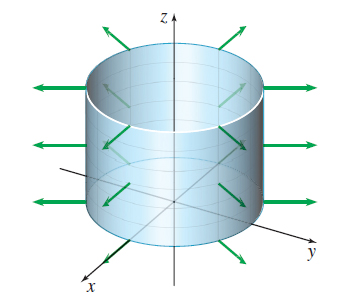EXAMPLE 7Finding the Flux of F Across a Cylinder
A fluid has a constant mass density ρ. Find the mass of fluid flowing across the cylinder x2+y2=4, where 0≤z≤3, in a unit of time in the direction outward from the z-axis, if the velocity of the fluid at any point on the cylinder is F=F(x,y,z)=xi+yj+2zk. That is, find the flux of F across the cylinder.
Solution In cylindrical coordinates x2+y2=r2=4, or equivalently, r=2, which leads to the parametrization r(θ,z)=2cosθi+2sinθj+zk, 0≤θ≤2π, 0≤z≤3.
We seek ‖ and dS.
The partial derivatives of \mathbf{r} are \begin{eqnarray*} \mathbf{r}_{\theta }&=&-2\sin \theta \,\mathbf{i}+2\cos \theta \,\mathbf{j}\quad \quad \ \mathbf{r}_{z}=\mathbf{k}\\[4pt] \mathbf{r}_{\theta }\times \mathbf{r}_{z} &=& \left|\begin{array}{c@{\quad}c@{\quad}c} \mathbf{i} & \mathbf{j} & \mathbf{k} \\[3pt] -2\sin \theta & 2\cos \theta & 0 \\[3pt] 0 & 0 & 1 \end{array}\right| =2\cos \theta\, \mathbf{i}+2\sin \theta\, \mathbf{j} \\[4pt] \left\Vert \mathbf{r}_{\theta }\times \mathbf{r}_{z}\right\Vert &=&\sqrt{ 4\cos ^{2}\theta +4\sin ^{2}\theta }=2 \\[4pt] dS &=&\left\Vert \mathbf{r}_{\theta }\times \mathbf{r}_{z}\right\Vert d\theta \,dz=2\,d\theta \,dz \end{eqnarray*}

Then the unit normal vector \mathbf{n} is \begin{equation*} \mathbf{n}=\dfrac{\mathbf{r}_{\theta}\times \mathbf{r}_{z}}{\left\Vert \mathbf{r}_{\theta}\times \mathbf{r}_{z}\right\Vert }=\dfrac{2\cos \theta\, \mathbf{i}+2\sin \theta\, \mathbf{j}}{2}=\cos \theta\, \mathbf{i}+\sin \theta\, \mathbf{j} \end{equation*}
These vectors point outward from the surface of the cylinder, so we have the correct orientation. Figure 65 shows the cylinder x^{2}+y^{2}=4, where 0\leq z\leq 3, and the outer unit normal vectors to the cylinder.
We now write \mathbf{F} using the parametrization. \mathbf{F}=\mathbf{F}(x,y,z)=\mathbf{F}(\theta ,z)=2\cos \theta \,\mathbf{i} +2\sin \theta \,\mathbf{j}+2z\,\mathbf{k}
The velocity of the fluid in the direction of \mathbf{n} is \begin{equation*} \mathbf{F\,{\cdot}\, n}=\left( 2\cos \theta \,\mathbf{i}+2\sin \theta \,\mathbf{j} +2z\,\mathbf{k}\right) \,{\cdot}\, \left( \cos \theta\, \mathbf{i}+\sin \theta\, \mathbf{j}\right) =2\cos ^{2}\theta \,+2\sin ^{2}\theta =2 \end{equation*}
The mass of fluid flowing across the cylinder x^{2}+y^{2}=4 in a unit of time in the direction of \mathbf{n} is given by \iint\limits_{\kern-3ptS}\rho \,\mathbf{F}\,{\cdot}\, \mathbf{n}\,dS=\int_{0}^{3} \int_{0}^{2\pi }\left( \rho \,2\right) 2\,d\theta \,dz=4\rho \int_{0}^{3}2\pi \,dz=\left( 8\rho \pi \right) 3=24\rho \pi
The flux of \mathbf{F} across S is 24\rho \pi.